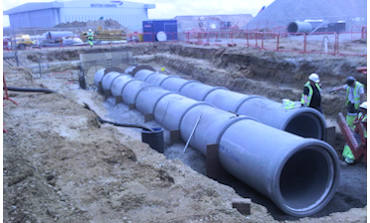
| | Ferrovial Agroman |
| | £1,500,000 |
| | Heathrow Airport, London |
| | Aug 2012 |
| | Jun 2013 |
VGC was engaged by main contractor Ferrovial Agroman to install an extensive storm water drainage system to remove the large quantities of rainwater from the taxiways and aprons of Heathrow terminal 2 aircraft stands. The work included the installation of approximately 1700 metres of concrete pipes varying between 750mm and 1200mm in diameter in single and twin pipe configurations. VGC also constructed 16 large manholes to provide access to the drainage system.
Undertaking construction activities within a working airport requires considerable planning to ensure that materials and plant arrive exactly when needed. The programme has to fit in with other construction activity and the complex operations of the airport itself. All work undertaken in airside locations at Heathrow has to be done under conditions of strict security and all personnel are required to be cleared before starting work. To assist in this process VGC underwent a thorough accreditation process and is now authorised to issue passes for this purpose.
Part of the Terminal 2 development included modification of existing aircraft stands and the construction of a further ten.
Heathrow Airport is the third busiest airport in the world in terms of passenger numbers and handles more international passengers than any other airport. In order to meet the increasing demand for passenger throughput Heathrow has invested heavily in improving the efficiency and capacity of its passenger terminals. The new Terminal 2 building is being constructed on the site of the Queens Building and the old 1955 Terminal 2 building which it replaces. The first phase of the new Terminal 2 will open in 2014 and the final phase in 2019 when the facility will be able to handle 30 million passengers per year.